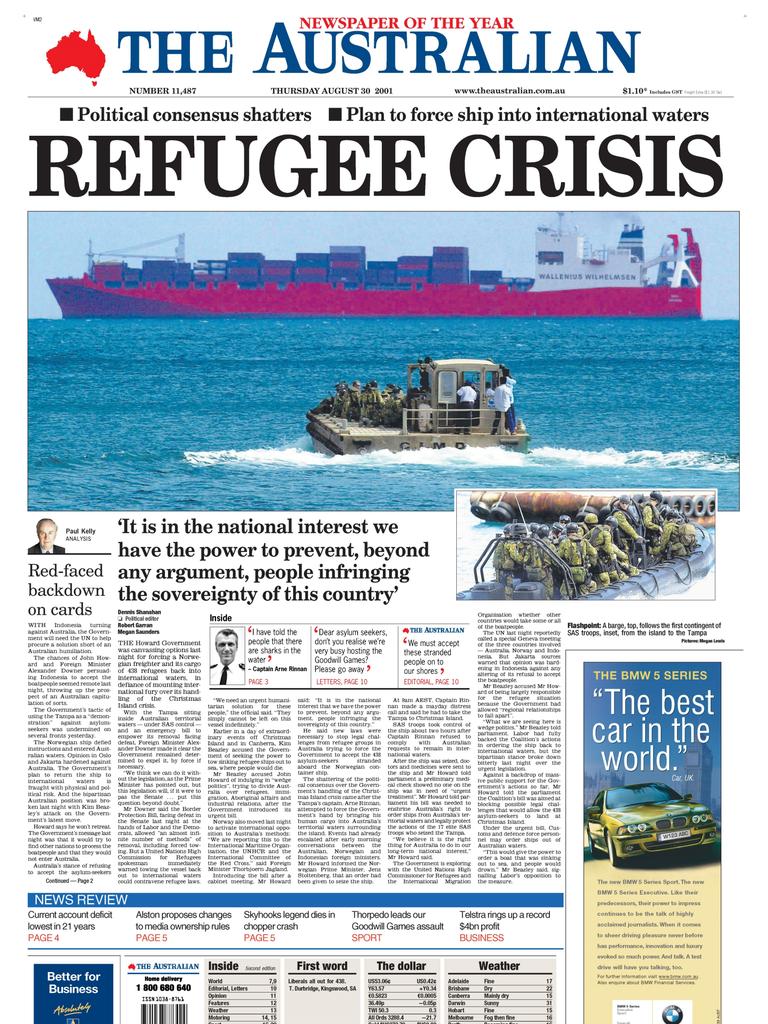John Howard knows his 2001 policies following Tampa were ‘controversial’ but stands by them
A host of sweeping ‘controversial’ measures have guided immigration policy for two decades, and John Howard still stands by them.

Twenty years on from the asylum seeker crisis that changed the course of Australia’s refugee policy, former prime minister John Howard maintains he did the right thing and has no guilt.
With Australia’s humanitarian commitment still a key policy and social commentary point in 2021, Mr Howard’s “controversial” policy, laid bare in the 2001 cabinet papers released on Saturday, has left a lasting legacy.
Between 1999 and 2001, more than 12,000 asylum seekers arrived “illegally” by sea and sought protection from the Australian government – many of whom were denied.
By 2002, following a suite of measures introduced over a course of weeks in late 2001, no boats arrived illegally.
The turning point came in late August 2001 when a wooden fishing boat carrying more than 400 mostly Hazara asylum seekers called for help.


Those on-board were rescued by the nearest vessel, a Norwegian freighter called the Tampa.
Captain Arne Rinnan was directed by Australia’s maritime authorities to take the 438 asylum seekers back to Indonesia, but those on-board requested to instead be taken to Christmas Island and threatened to jump overboard if their request was not met.
After days of back and forth between Captain Rinnan and Australian authorities, and despite multiple warnings, the Tampa crossed into Australia’s territorial waters and was immediately intercepted.

In the days that followed, the Howard government rushed through a suite of new measures to prevent asylum seekers arriving by illegal means to claim asylum in Australia.
The Pacific Solution was entered into shortly after, with cabinet documents from 2001 – released on Saturday by the National Archives of Australia – revealing how quickly the government sought to act to sign a deal for those asylum seekers to be sent to Nauru and New Zealand.
The Pacific Solution would continue until February 2008.

Cabinet documents also reveal the swift moves the Howard government took to ensure asylum seekers who arrived on Cocos and Christmas Islands would not be able to apply for refugee status by removing those jurisdictions from Australia’s migration zone.
While Mr Howard’s actions on Tampa are almost directly correlated to his party’s success at the 2001 election, just a few weeks after the change in policy more than 350 people died after their boat struck trouble in the Java Sea.
Around the same time, the government said asylum seekers on board another vessel had thrown their children overboard in an attempt to enter Australia. That claim was debunked when The Australian newspaper broke the front page story that the “Children Overboard” incident never happened.

Twenty years on, when asked whether he had ever felt any guilt about his government’s tough immigration policy, Mr Howard said there had “never been a doubt” that the course of action his government took in 2001 was the “right thing to do”.
“I thought it was a very tough policy, but it was the right policy,” he said.
“I think the Australian policy did save lives. It was controversial, but it wasn’t something you could have both ways.
“You couldn’t have a firm policy … If you have an optimistic view about the capacity of this country to continue taking in a large number of migrants, and also having a sizeable humanitarian program, you have to always remember that the maintenance of those two things depends crucially on the acceptance of immigration by the Australian people.
“And the evidence is overwhelming – whenever the public thinks immigration is out of control, the support drops, but once they see it back under control, then most Australians have quite a positive view.”

In the 20 years since the Tampa, Australia’s immigration policy has remained underpinned by the sweeping set of changes the Howard government introduced.
While Labor ended offshore processing in February 2008, that coincided with a dramatic increase worldwide in the number of refugees seeking asylum.
The LNP’s “Stop the Boats” campaign, and Labor’s resumption of offshore processing in 2012, heralded another shift in policy.
By the time Tony Abbott won government in 2013, the party began rolling out measures stronger than Mr Howard’s in 2001.



